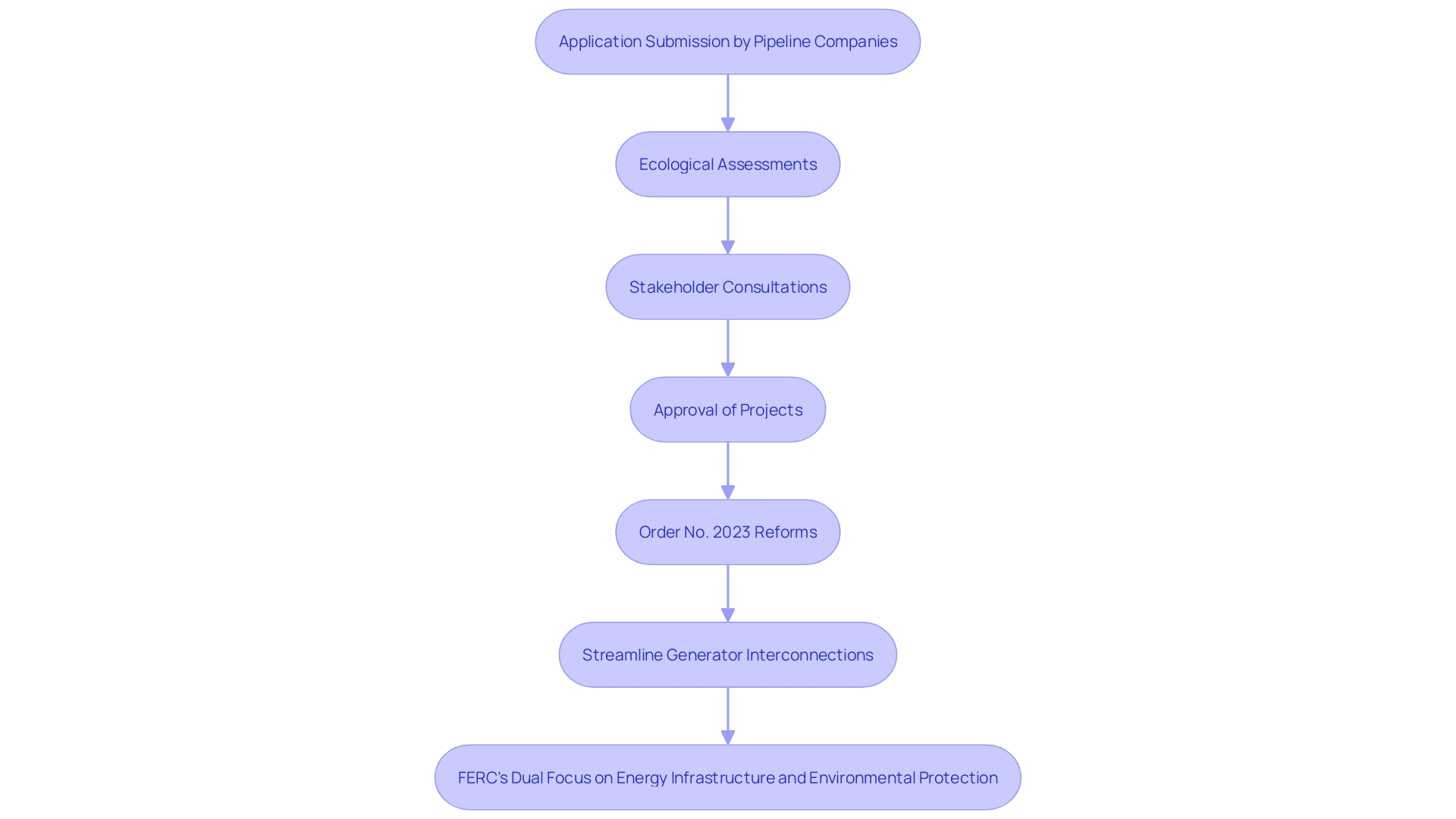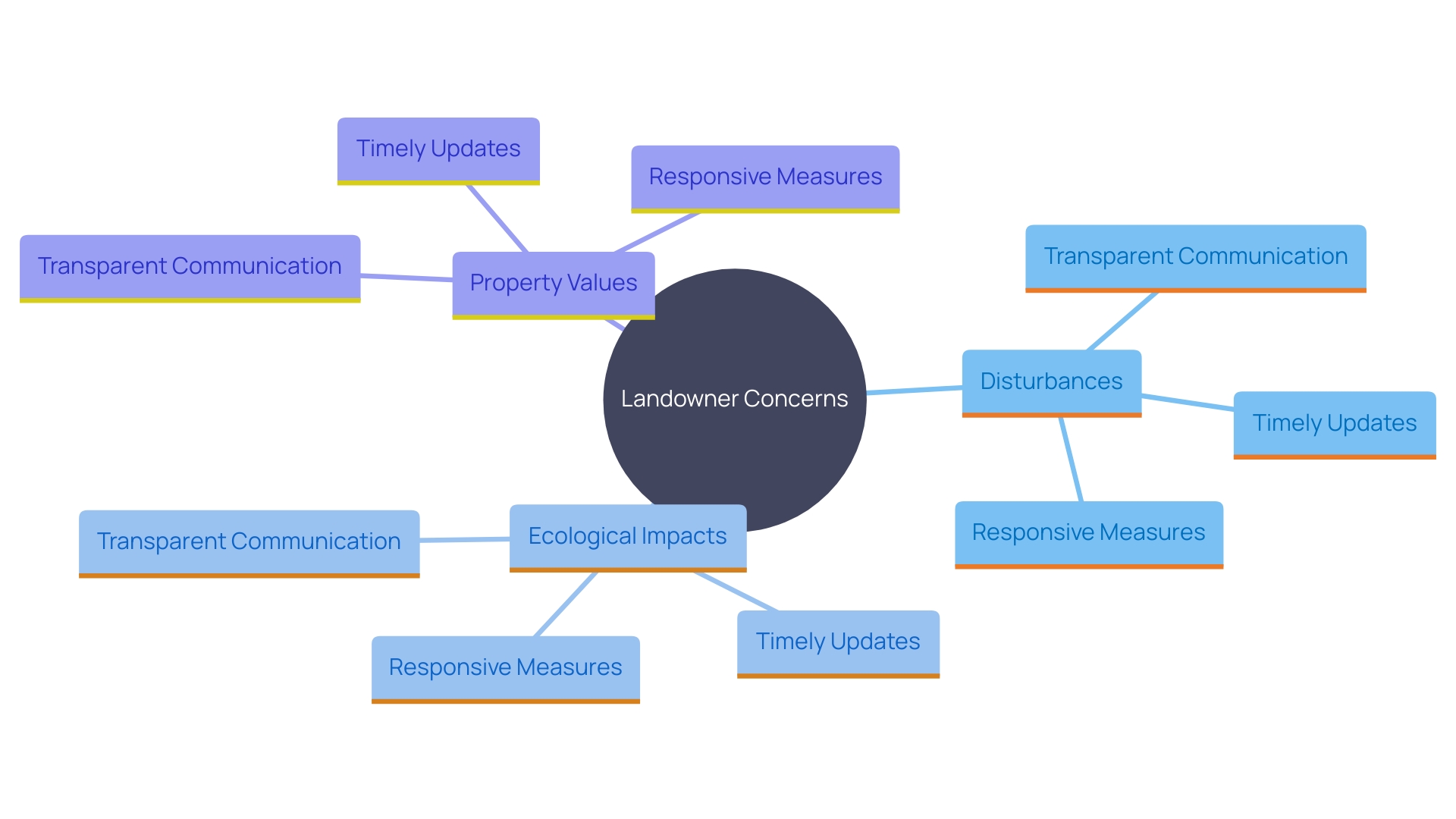Introduction
The acquisition of land for pipeline construction is governed by a complex legal framework that varies across federal, state, and local jurisdictions. Federally, the process is significantly influenced by the Natural Gas Act and other relevant statutes, with the Federal Energy Regulatory Commission (FERC) overseeing interstate pipelines. FERC’s regulatory process is exhaustive, involving stakeholder consultations, environmental assessments, and ensuring compliance with safety standards.
This oversight is increasingly critical as the demand for transmission lines rises due to the expansion of renewable energy projects, such as wind, solar, and carbon capture initiatives. Understanding these legal intricacies is essential for stakeholders in pipeline construction, as evidenced by recent legal disputes and regulatory adjustments within the energy sector.
Legal Framework for Pipeline Land Acquisition
The legal structure regulating property acquisition for conduits is complex and differs greatly by jurisdiction, including federal, state, and local regulations. Federally, the Natural Gas Act and other pertinent statutes empower pipeline companies to acquire land, with the Federal Energy Regulatory Commission (FERC) playing a pivotal role in overseeing interstate pipelines. FERC's regulatory process is comprehensive, involving stakeholder consultation, identification of ecological issues, and preparation of documents like Assessments or Impact Statements. 'This regulatory oversight ensures adherence to environmental and safety standards, vital amid the increasing demand for transmission lines fueled by the rise in renewable energy endeavors, including wind, solar, and carbon capture initiatives.'. Grasping these legal intricacies is essential for parties engaged in infrastructure development, as demonstrated by recent legal conflicts and regulatory modifications impacting the energy industry.

Eminent Domain in Pipeline Construction
Eminent domain is a legal principle that permits government entities and certain private companies to acquire private property for public use, contingent upon fair compensation to the property owners. 'In the field of conduit construction, this principle is frequently applied to acquire essential easements or property segments vital for the project.'. While the process aims to balance public interest with private property rights, it frequently raises significant concerns among landowners. One prominent issue is the valuation of their properties, which can be a point of contention. Furthermore, the potential impacts on their land, such as environmental changes and reduced property usability, add to the apprehensions. 'The Supreme Court's recent refusal to consider Virginia landowners' case against the Mountain Valley project exemplifies the ongoing struggles between landowners and developers.'. 'Despite legal disputes, the Federal Energy Regulatory Commission continues to grant approvals, highlighting the complexities and challenges inherent in the eminent domain process for energy infrastructure initiatives.'.

Federal Regulations: FERC's Role in Interstate Pipelines
The Federal Energy Regulatory Commission (FERC) plays a pivotal role in the regulation of interstate conduits across the United States. Among its key responsibilities are approving pipeline construction projects, conducting thorough ecological assessments, and ensuring that public interests are safeguarded. Pipeline companies are required to submit comprehensive applications to FERC, which must detail potential land impacts and demonstrate compliance with federal laws. This process involves extensive consultation with stakeholders and preparation of documents related to the environment, such as Assessments or Impact Statements.
FERC's oversight extends beyond conduits to include reforms in generator interconnection processes, as seen in the recent Order No. 2023. This rule aims to streamline the integration of new generating facilities into the existing transmission grid, addressing backlogs and improving process certainty. These reforms highlight FERC's commitment to balancing the need for robust energy infrastructure with environmental protections and community concerns. The agency's proactive approach in developing regulations through the rulemaking process ensures that both industry and public interests are considered, thereby fostering a more sustainable and efficient energy sector.

Negotiating Pipeline Easements and Rights-of-Way
Bargaining for easements and rights-of-way is an essential part of property acquisition for conduit projects. Pipeline firms seek to establish legal contracts with property owners to use their territory for construction and upkeep. These negotiations are often intricate, involving compensation, land use, and potential disruptions. Successful negotiation tactics are essential to ensuring that both transport companies and landowners achieve mutually advantageous agreements while reducing disputes.
The complexity of these negotiations can be seen in cases like the Mountain Valley pipeline, where legal disputes over federal approvals have highlighted the challenges faced by both developers and landowners. According to legal expert Eric C. Camp, protecting property rights and adding value to transactions are essential aspects of these negotiations. Camp's experience underscores the importance of strategic planning and understanding the legal landscape to navigate these complex interactions successfully.
Additionally, the rise in renewable energy initiatives has introduced another level of complexity, with property owners and developers frequently conflicting over usage. Meghan Dawson McElvy observes that the significant increase in renewable energy production, especially in wind and solar, has heightened the need for transmission lines, making acquisition negotiations more complex. These initiatives can lead to significant disputes if not managed carefully, emphasizing the need for effective community engagement and transparent communication to resolve opposition and build consensus.
Data indicate that numerous conduits, including those on federal territories, present safety and ecological hazards if not adequately retired. This emphasizes the significance of comprehensive data gathering and prioritization to tackle these risks, ensuring that discussions for new initiatives take into account long-term safety and ecological effects.
In conclusion, negotiating easements and rights-of-way requires a comprehensive understanding of legal, logistical, and community factors. By employing effective negotiation strategies and fostering collaboration among stakeholders, energy companies can secure the necessary agreements while maintaining positive relationships with landowners and minimizing potential conflicts.
Addressing Landowner Concerns During Pipeline Construction
'Landowners frequently have considerable worries during the building stage of conduit projects, including possible disturbances to their land, ecological impacts, and lasting effects on property values.'. Addressing these concerns is crucial for maintaining positive relationships between pipeline companies and the communities they impact.
Transparent communication is key. For instance, the Federal Energy Regulatory Commission (FERC) emphasizes early public participation in the natural gas pre-filing review process. This approach allows for the identification and resolution of potential environmental issues and impacts, and provides resources to assist the public.
Timely updates also play a vital role. The Common Market for Eastern and Southern Africa, in collaboration with the World Bank, has launched a USD 50 million regional platform to support clean energy projects by filling technical knowledge gaps. By keeping stakeholders informed and engaged, such initiatives can help alleviate anxieties and foster cooperation.
Responsive measures to mitigate adverse effects are equally important. For instance, the decommissioning of outdated conduits on federal lands emphasizes the necessity for improved data to prioritize those that pose the greatest risks. Implementing these measures can prevent safety and environmental risks, thereby addressing landowners' concerns effectively.
Engaging with communities through structured processes and providing consistent updates ensures that landowners feel heard and respected. This approach not only mitigates concerns but also builds a foundation of trust and cooperation essential for the successful completion of pipeline projects.

Conclusion
The legal framework for land acquisition in pipeline construction is complex, involving federal, state, and local regulations, with the Natural Gas Act and the Federal Energy Regulatory Commission (FERC) at the forefront. Stakeholders must navigate these intricacies, especially given recent legal disputes and the rising demand for renewable energy transmission lines.
Eminent domain allows for the acquisition of private property for public use, but this often generates conflicts regarding property valuation and land usability. Legal challenges, such as those involving the Mountain Valley pipeline, illustrate the ongoing tensions surrounding this principle.
FERC's role extends beyond project approvals to include comprehensive environmental assessments and protecting public interests. Their efforts to streamline processes reflect a commitment to balancing energy infrastructure needs with environmental safeguards.
Negotiating easements and rights-of-way is critical, requiring effective strategies to align the interests of pipeline companies and landowners. The growth of renewable energy projects adds complexity, underscoring the importance of transparent communication and community engagement.
Addressing landowner concerns during construction is essential for fostering positive relationships. Open communication, timely updates, and measures to mitigate impacts can alleviate anxieties and build trust within communities.
In summary, effective navigation of the legal, regulatory, and community dynamics in pipeline construction demands strategic planning and collaboration. Prioritizing communication will ensure that energy infrastructure development aligns with both public and private interests, supporting a sustainable energy future.




